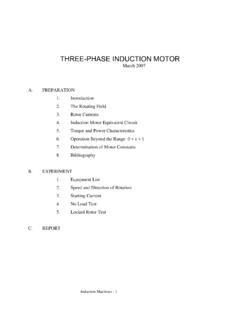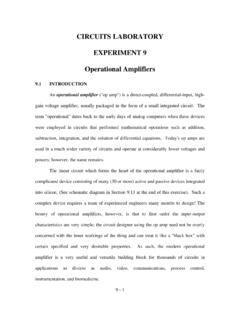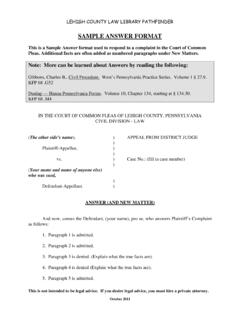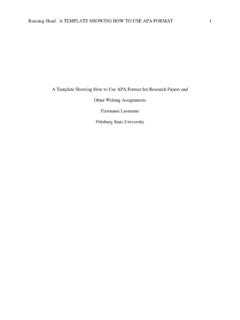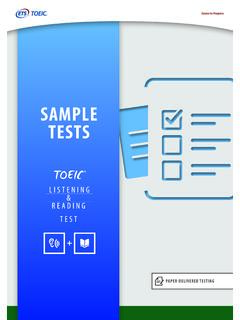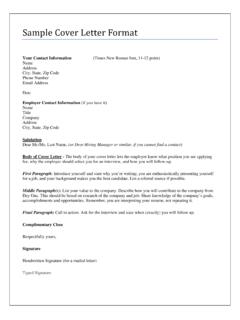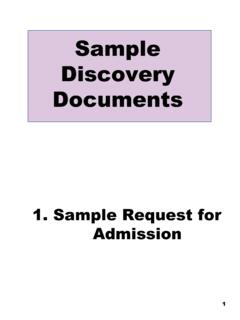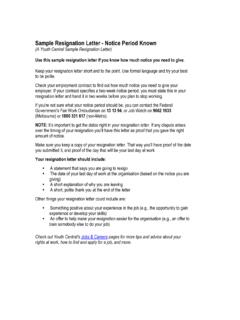Transcription of Lab #1 – Sample Lab Report Format
1 Washington University Dept. of Mechanical, Aerospace & Structural Engineering Lab #1 Sample Lab Report Format MEMS 431 Structural Dynamics and Vibrations Loren Ahaus June 1, 2010 Abstract The abstract summarizes four essential aspects of the Report : the purpose of the experiment, key findings, significance and major conclusions. The abstract often also includes a brief mention of the theory or methodology. The information should clearly enable readers to decide whether they need to read your whole Report . The abstract should be one paragraph of 100-200 words and should not contain any references. Introduction The introduction should first provide a concise statement of the objective or motivation for the lab.
2 It should then provide a general overview of the theory and the basic approach used. Much of this information will be provided in the lab manual. However, the information should be restated in your own words. This section gives the 30,000 ft view, the big picture. More details are provided in the Theory and Procedure sections. Theory This section provides all of the background information, theory, and equations necessary to understand the experiment. For instance, a good place to start is with a free body diagram of the system being studied, as shown in Fig. 1. L center of rotation elastic axis L m , I h e f d M elastic axis M Figure 1. Free body diagram A brief derivation of the key equations should be given.
3 The derivation should be a coherent, logical narrative in your own words. Equations should be numbered. Standard practice is to center the equations and write the equation numbers in parentheses on the right hand side. An example is given below. From Newton s Second Law, (1) The force must be the same for mass 1 and mass 2. (2) Equations (1) and (2) are combined and rearranged to provide an expression for the acceleration of mass 2. (3) Equations should be entered using Equation Editor or similar software, rather than simply being typed in plain text. Procedure The procedure should include step-by-step instructions of the procedure used in the lab.
4 Most of this information is given in the lab manual; however, the information should be organized neatly and given in complete sentences. A schematic of the experimental setup should be given, as shown in Fig. 2. Detailed information about the equipment used in the experiment, such as model number, dimensions, speed, etc. can either be included in this section or in an appendix. Figure 2. Equipment used in the experiment. Results This section presents the results of the experiment in a way that illustrates their significance. This is usually best done by a plot, as shown in Fig. 3. When comparing experimental data to a curve fit or theoretical result, the experimental data should be shown with individual data markers and no lines connecting them.
5 The analytical result should be shown with a line (no individual data markers). When presenting a plot, remember the following rules of thumb. The plot should contain x- and y-axis labels with units. If two plots are being compared to each other, the axis limits should be the same for each plot. Plots are often reduced in size when copied into the Report . Make sure the resulting text size on the plot is at least as large as the font in the body of the Report . For a small amount of experimental data, the raw data should be included in tabular Format , as shown in Table 1. If the amount of raw data would distract from the flow of the Report , it should be included in an appendix, instead of the body.
6 Remember to include units for the tabulated data as well. Figure 3. Calibration curve for force transducer. Table 1. Force and voltage measurements. Force (N) Voltage (V) (N)Voltage (V)k = V/N ExperimentLinear FitDiscussion This is the most important part of the Report , because this is where you demonstrate your understanding of the physics, beyond simply completing the steps of the procedure. This section should answer the following questions: What do the results indicate clearly? Do the results match with the a priori predictions from the theory? What is the significance of the results? What ambiguities exist?
7 You should explain your results in terms of theoretical issues and relate them to the experiment objective. Analyze the sources of error in the experiment. Conclusion The conclusion should sum up the lab, including the key results and conclusions. If problems were identified with the data, discuss how these may have affected your results. The conclusion should be one or two paragraphs that succinctly summarize the essence of the lab Report . References This section includes bibliographic references for any outside texts used during the writing of the Report . Generally, these references are used for the theory and background. You do not need to reference the lab manual, but all other outside sources should be referenced, including page numbers.
8 The following example shows one acceptable reference style. [1] Issacs, R., Airfoil Theory for Flows of Variable Velocity, Journal of the Aeronautical Sciences, Vol. 12, (1), 1945, pp. 113-117. [2] Abbott, Ira H. and Van Doenhoff, Albert E. , Theory of Wing Sections, Dover Publications, New York, 1980, pp. 46-63. Appendix The appendix should be used to put any information that is too extensive to fit in the body of the Report . If the volume of information disrupts the flow of the Report , it should be included in the appendix. The appendix may also be used to include Sample calculations.
